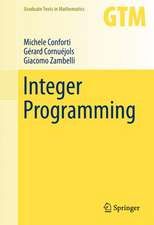Data Envelopment Analysis: A Handbook of Modeling Internal Structure and Network: International Series in Operations Research & Management Science, cartea 208
Editat de Wade D. Cook, Joe Zhuen Limba Engleză Hardback – 26 feb 2014
| Toate formatele și edițiile | Preț | Express |
|---|---|---|
| Paperback (1) | 959.36 lei 6-8 săpt. | |
| Springer Us – 11 aug 2016 | 959.36 lei 6-8 săpt. | |
| Hardback (1) | 975.29 lei 6-8 săpt. | |
| Springer Us – 26 feb 2014 | 975.29 lei 6-8 săpt. |
Din seria International Series in Operations Research & Management Science
- 20%
 Preț: 331.25 lei
Preț: 331.25 lei - 9%
 Preț: 696.06 lei
Preț: 696.06 lei - 20%
 Preț: 570.62 lei
Preț: 570.62 lei - 18%
 Preț: 1132.02 lei
Preț: 1132.02 lei - 18%
 Preț: 773.72 lei
Preț: 773.72 lei -
 Preț: 170.40 lei
Preț: 170.40 lei - 17%
 Preț: 459.35 lei
Preț: 459.35 lei - 17%
 Preț: 360.48 lei
Preț: 360.48 lei -
 Preț: 263.40 lei
Preț: 263.40 lei - 24%
 Preț: 905.31 lei
Preț: 905.31 lei - 17%
 Preț: 460.09 lei
Preț: 460.09 lei - 17%
 Preț: 459.35 lei
Preț: 459.35 lei - 20%
 Preț: 631.58 lei
Preț: 631.58 lei - 13%
 Preț: 480.01 lei
Preț: 480.01 lei - 18%
 Preț: 738.28 lei
Preț: 738.28 lei - 18%
 Preț: 1225.94 lei
Preț: 1225.94 lei - 18%
 Preț: 948.92 lei
Preț: 948.92 lei - 18%
 Preț: 703.88 lei
Preț: 703.88 lei - 18%
 Preț: 957.44 lei
Preț: 957.44 lei - 15%
 Preț: 651.84 lei
Preț: 651.84 lei - 20%
 Preț: 336.21 lei
Preț: 336.21 lei - 15%
 Preț: 641.03 lei
Preț: 641.03 lei -
 Preț: 404.29 lei
Preț: 404.29 lei - 18%
 Preț: 950.21 lei
Preț: 950.21 lei - 15%
 Preț: 649.06 lei
Preț: 649.06 lei - 18%
 Preț: 725.75 lei
Preț: 725.75 lei -
 Preț: 394.12 lei
Preț: 394.12 lei - 18%
 Preț: 951.47 lei
Preț: 951.47 lei - 15%
 Preț: 639.59 lei
Preț: 639.59 lei - 18%
 Preț: 773.06 lei
Preț: 773.06 lei - 18%
 Preț: 889.29 lei
Preț: 889.29 lei - 15%
 Preț: 655.60 lei
Preț: 655.60 lei - 15%
 Preț: 640.06 lei
Preț: 640.06 lei
Preț: 975.29 lei
Preț vechi: 1189.38 lei
-18% Nou
Puncte Express: 1463
Preț estimativ în valută:
186.61€ • 194.86$ • 154.10£
186.61€ • 194.86$ • 154.10£
Carte tipărită la comandă
Livrare economică 15-29 aprilie
Preluare comenzi: 021 569.72.76
Specificații
ISBN-13: 9781489980670
ISBN-10: 1489980679
Pagini: 612
Ilustrații: XII, 599 p. 109 illus., 41 illus. in color.
Dimensiuni: 155 x 235 x 38 mm
Greutate: 1.3 kg
Ediția:2014
Editura: Springer Us
Colecția Springer
Seria International Series in Operations Research & Management Science
Locul publicării:New York, NY, United States
ISBN-10: 1489980679
Pagini: 612
Ilustrații: XII, 599 p. 109 illus., 41 illus. in color.
Dimensiuni: 155 x 235 x 38 mm
Greutate: 1.3 kg
Ediția:2014
Editura: Springer Us
Colecția Springer
Seria International Series in Operations Research & Management Science
Locul publicării:New York, NY, United States
Public țintă
ResearchCuprins
DEA for Two-State Networks: Efficiency Decompositions and Modeling Techniques.- Network DEA Pitfalls: Divisional Efficiency and Frontier Projection.- Efficiency Decomposition in Network Data Envelopment Analysis.- Two-Stage Network Processes: DEA Frontier Identification.- Additive Efficiency Decomposition in Network DEA.- Scale Efficiency Measurement in Two-Stage Production Systems.- Decomposing Efficiency and Returns to Scale in Two-Stage Network Systems.- Evaluating Two-Stage Network Structures: Bargaining Game Approach.- Shared Resources and Efficiency Decomposition in Two-Stage Networks.- A Network DEA Model with Internal Dynamic Effect.- Slacks-Based Network DEA.- DEA Models for Extended Two-Stage Network Structures.- An Efficiency Measurement Framework for Multi-Stage Production Systems.- Network DEA II.- Network, Shared Flow and Multi-Level DEA Models: A Critical Review.- Multicomponent Efficiency Measurement in Banking.- Evaluating Power Plant Efficiency: Hierarchical Models.- Multicomponent Efficiency: Measurement and Core Business Identification in Multiplant Firms.- Two-Stage Network DEA with Bad Outputs.- Performance Measurement of Major League Baseball Teams Using Network DEA.- Production and Marketing Efficiencies of the U.S. Airline Industry: A Two-Stage Network DEA Approach.- Network Representations of Efficiency Analysis for Engineering Systems: Examples, Issues and Research Opportunities.
Textul de pe ultima copertă
This handbook serves as a complement to the Handbook on Data Envelopment Analysis (eds, W.W. Cooper, L.M. Seiford, and J, Zhu, 2011, Springer) in an effort to extend the frontier of DEA research. It provides a comprehensive source for the state-of-the art DEA modeling on internal structures and network DEA. Chapter 1 provides a survey on two-stage network performance decomposition and modeling techniques. Chapter 2 discusses the pitfalls in network DEA modeling. Chapter 3 discusses efficiency decompositions in network DEA under three types of structures, namely series, parallel, and dynamic. Chapter 4 studies the determination of the network DEA frontier. In chapter 5 additive efficiency decomposition in network DEA is discussed. An approach in scale efficiency measurement in two-stage networks is presented in chapter 6. Chapter 7 further discusses the scale efficiency decomposition in two stage networks.
Chapter 8 offers a bargaining game approach to modeling two-stage networks. Chapter 9 studies shared resources and efficiency decomposition in two-stage networks. Chapter 10 introduces an approach to computing the technical efficiency scores for a dynamic production network and its sub-processes. Chapter 11 presents a slacks-based network DEA. Chapter 12 discusses a DEA modeling technique for a two-stage network process where the inputs of the second stage include both the outputs from the first stage and additional inputs to the second stage. Chapter 13 presents an efficiency measurement methodology for multi-stage production systems. Chapter 14 discusses network DEA models, both static and dynamic. The discussion also explores various useful objective functions that can be applied to the models to find the optimal allocation of resources for processes within the black box, that are normally invisible to DEA. Chapter 15 provides a comprehensive review of various type network DEA modeling techniques.
Chapter 16presents shared resources models for deriving aggregate measures of bank-branch performance, with accompanying component measures that make up that aggregate value. Chapter 17 examines a set of manufacturing plants operating under a single umbrella, with the objective being to use the component or function measures to decide what might be considered as each plant’s core business. Chapter 18 considers problem settings where there may be clusters or groups of DMUs that form a hierarchy. The specific case of a set off electric power plants is examined in this context. Chapter 19 models bad outputs in two-stage network DEA. Chapter 20 presents an application of network DEA to performance measurement of Major League Baseball (MLB) teams. Chapter 21 presents an application of a two-stage network DEA model for examining the performance of 30 U.S. airline companies. Chapter 22 then presents two distinct network efficiency models that are applied to engineering systems.
Chapter 8 offers a bargaining game approach to modeling two-stage networks. Chapter 9 studies shared resources and efficiency decomposition in two-stage networks. Chapter 10 introduces an approach to computing the technical efficiency scores for a dynamic production network and its sub-processes. Chapter 11 presents a slacks-based network DEA. Chapter 12 discusses a DEA modeling technique for a two-stage network process where the inputs of the second stage include both the outputs from the first stage and additional inputs to the second stage. Chapter 13 presents an efficiency measurement methodology for multi-stage production systems. Chapter 14 discusses network DEA models, both static and dynamic. The discussion also explores various useful objective functions that can be applied to the models to find the optimal allocation of resources for processes within the black box, that are normally invisible to DEA. Chapter 15 provides a comprehensive review of various type network DEA modeling techniques.
Chapter 16presents shared resources models for deriving aggregate measures of bank-branch performance, with accompanying component measures that make up that aggregate value. Chapter 17 examines a set of manufacturing plants operating under a single umbrella, with the objective being to use the component or function measures to decide what might be considered as each plant’s core business. Chapter 18 considers problem settings where there may be clusters or groups of DMUs that form a hierarchy. The specific case of a set off electric power plants is examined in this context. Chapter 19 models bad outputs in two-stage network DEA. Chapter 20 presents an application of network DEA to performance measurement of Major League Baseball (MLB) teams. Chapter 21 presents an application of a two-stage network DEA model for examining the performance of 30 U.S. airline companies. Chapter 22 then presents two distinct network efficiency models that are applied to engineering systems.
Caracteristici
Editors are two of the most prominent researchers in the field Prestigious group of contributors Covers the cutting edge topics not covered in the latest version of the Handbook Includes supplementary material: sn.pub/extras











